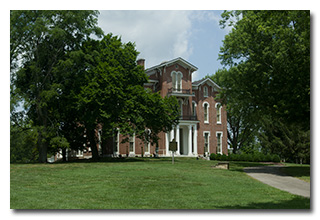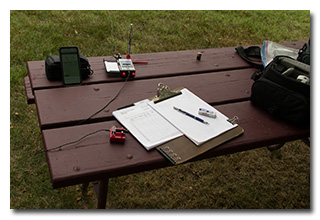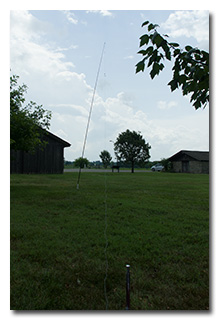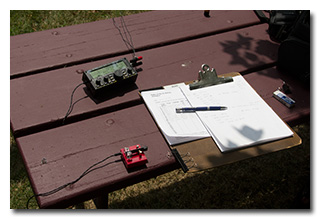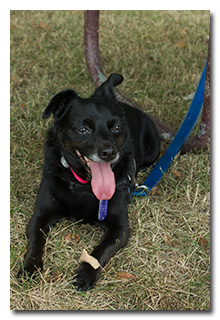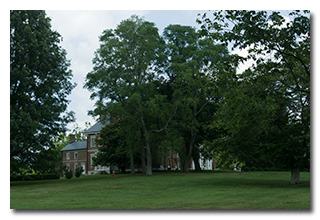
by William Eric McFadden
From the EKU website:
-
White Hall; a sprawling 44 room mansion tucked away in the beautiful farmland of northern Madison County, was called home by more than one notable figure in history. First built in 1799 by Green Clay, a prominent businessman, surveyor, and slave owner, the original home contained seven rooms and spanned roughly 3,000 square feet. The home was later passed on to his son Cassius Marcellus Clay, a writer and politician known for his emancipationist views and his role as U.S. Minister to Russia. Cassius Clay's daughters were incredibly active in the Women's Suffrage Movement, including Laura Clay, who went on to become the first woman to be nominated a candidiate for President of the United States. During Cassius Clay's time in Russia, his wife Mary Jane Warfield oversaw the contrstruction of the building's addition, expanding it to the 10,000+ square foot mansion we see today.
Pictures
- Eric's KH1 station
- Eric's ad hoc 35' EFRW antenna
- Eric's KX2 station
- Theo-dog, hiding in the shade
- White Hall, as viewed from the picnic area
- White Hall, as viewed from the front
Description
On Sunday, June 30, 2024, one member of the Southeast Ohio Radio Adventure Team performed a successful activation of White Hall State Historic Site in Kentucky as part of the Parks on the Air (POTA; link) program.
While in Lexington, Kentucky, for the annual McFadden family reunion (always on the last Sunday in June), Eric McFadden, WD8RIF, stopped at White Hall State Historic Site for a quick activation of this new-to-him POTA unit. He was accompanied by his wife, Vickie, and their two small dogs, Theo and Ginny.
After getting a late start from their hotel, and then spending what felt like an eternity at what might well have been the world's slowest Waffle House for breakfast, the travelers were about an hour late departing for White Hall State Historic Site. Then, while driving on I-75 South, and approaching White Hall, they drove through a true "gully washer" of a rainstorm, and Eric began to wonder if he should just give up entirely on the idea of the activation. However, they drove out of the rain and arrived at White Hall about 1530 UTC to find a blue sky, puffy white clouds, and a nearly empty parking lot.
The idea had been that Vickie would take the tour of White Hall while Eric performed his activation and watched the dogs. This didn't work, however, because the tour would have started half an hour prior to their late arrival. Thus, Vickie chose to watch Ginny-dog while Eric, with Theo-dog at his side, performed the activation. The activation would have to be quick, though, with Eric figuring he had less than an hour to complete his activation if they were to arrive at the reunion in Georgetown on time.
Eric was pleased to see that he had good cell-signal at White Hall, and that he would be able to spot himself on POTA Spots (link) and to use POTA Spots to identify possible park-to-park (P2P) QSO opportunities.
Finding a lovely picnic area in White Halls large yard, and noticing that despite they rain they had just driven through, the wooden picnic tables were already dry, Eric selected a table for his operating location. Hoping to make this a low-profile operation, Eric chose to use his Elecraft KH1 and the whip antenna system for his operation. Placing his KH1 on the picnic table, using the Tufteln (link) Right Angle Adapter, Eric configure his KH1 for 20m, installed the 4' telescoping whip, and placed the 13' counterpoise wire directly on the ground. He was on the air at 1541 UTC.
Eric found a clear frequency to run, began calling "CQ POTA", and self-spotted himself on POTA Spots. He was hoping that, perhaps, band conditions weren't too horrible despite a solar A-Index of 14 and a K-Index of 3, and that a silly 4' whip would prove to be sufficient for making his required ten QSOs. His first QSO came at 1548 UTC with K7IOL in Texas, and the signal reports of 599 (sent) and 559 (received) were reassuring. Then, nothing...
Realizing that, perhaps, band conditions were terrible and that an improved antenna might be needed, Eric collapsed the 4' whip and deployed his 35' ad hoc end-fed random wire (EFRW) antenna as a sloper up to the top of his Goture Red Fox Super Hard 720 carbon-fiber mast held upright on a spike. The ad hoc 35' EFRW wire consists of a radiator fashioned from the 33' drag-wire that comes with the Elecraft AXE1 40m coil plus a 2' extension, with the 13' drag-wire that comes with the KH1 placed on the ground as a counterpoise; these are connected to the KH1 through a binding-post adapter.
The ad hoc 35' EFRW antenna was a significant improvement over the 4' whip, and Eric's first QSO in his second run on 20m came at 1557 UTC with NR1D in Connecticut. As the heat and humidity quickly climbed following the rainstorm, QSOs came steadily, with Eric's seventh QSO in this run coming at 1607 UTC with K9PMM in Florida. Subsequent calls of "CQ POTA" resulted in the KH1 shutting off transmit while showing "HI TEMP" on the display, an indication that the KH1 was not at all happy about sitting in the direct sun on that hot and humid morning. Attempts to shield the KH1 with an available bag proved fruitless. This aborted run included a P2P QSO with KB5EDR who was activating Tawakoni Wildlife Management Area (US-6605) in Texas and QSOs with operators located in Connecticut, Texas (2), Missouri, Nevada (2), and Florida. Being two QSOs shy of the ten required for a valid activation, and rapidly running out time, Eric decided his best option would be to swap out the KH1 for his KX2 rather than wait for his KH1 to cool down.
After swapping in the KX2 and connecting it to the ad hoc 35' EFRW antenna, Eric was startled to discover that the best match the KX2 could find for the 35' EFRW antenna on 20m was 6:1. The KX2, however, easily found a good match on 40m, so Eric found a clear frequency on that band to run and began calling "CQ POTA". His first QSO in this run came at 1613 UTC with N5FY in Georgia. This was followed at 1617 UTC by a QSO with WD4MRI in Alabama, giving Eric the ten QSOs required for a valid activation.
Having just a minute or two to spare, Eric checked POTA Spots for P2P QSO opportunities and at 1619 UTC he made a P2P QSO on 40m with KD3D who was activating PA 152 State Game Land (US-8850) in Pennsylvania.
In all, Eric managed to make eleven QSOs, with two P2P QSOs. All of Eric's QSOs were CW and were made with five watts output.
Eric rushed through tearing down his station, packing up, and getting little Theo-dog into the car and starting the air-conditioning, and then ran around to snap some photos of the park.
(return)
